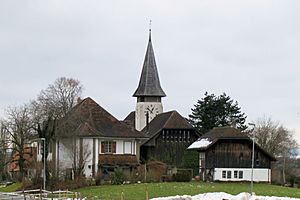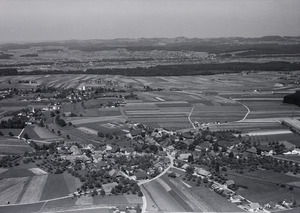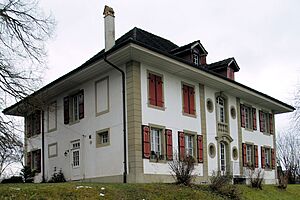Grafenried, Switzerland facts for kids
Quick facts for kids
Grafenried
|
||
|---|---|---|

Grafenried village and church
|
||
|
||
| Country | Switzerland | |
| Canton | Bern | |
| District | Bern-Mittelland | |
| Area | ||
| • Total | 4.7 km2 (1.8 sq mi) | |
| Elevation | 520 m (1,710 ft) | |
| Population
(Dec 2011)
|
||
| • Total | 980 | |
| • Density | 209/km2 (540/sq mi) | |
| Postal code |
3308
|
|
| Surrounded by | Etzelkofen, Fraubrunnen, Iffwil, Jegenstorf, Zauggenried | |
Grafenried used to be a municipality (like a small town) in the Bern-Mittelland area of Bern canton in Switzerland. On January 1, 2014, Grafenried joined with several other towns. These towns included Büren zum Hof, Etzelkofen, Limpach, Mülchi, Schalunen, and Zauggenried. They all became part of the larger municipality of Fraubrunnen.
Contents
History of Grafenried
Grafenried was first mentioned in old writings in 1258. Back then, it was called Gravenriet. A few years later, in 1262, it was known as Riede.
Ancient Times and the Middle Ages
The oldest sign of people living here is an ancient grave mound. It dates back to the Hallstatt culture, a time long ago. This mound was found at a place called Eichberg.
Scientists also found what might have been a Roman farm. They also discovered an abandoned village from the Late Middle Ages. During the Middle Ages, the village, its court, and the church belonged to the Counts of Thierstein.
In the 1200s, Fraubrunnen Abbey bought the whole village. Grafenried stayed under the abbey's control for many years.
Becoming Part of Bern
In 1528, the city of Bern adopted the Protestant Reformation. This meant they took over the abbey's lands, including Grafenried. Under Bern's control, Grafenried became part of the Fraubrunnen area. This area was also part of the Zollikofen court.
The Village Church
The first church in Grafenried was built a very long time ago. It was built in the 7th or 8th century. This early church was built over a Roman tomb outside the village.
In 1258, the village bought the right to choose its own church leader. In 1535, it became the main church for the municipality. The church you see today was built much later, in 1748.
Changes in the 19th and 20th Centuries
During the 1800s, many farmers in Grafenried changed what they grew. They switched from growing grain to raising dairy cows. A village dairy opened in 1848.
In 1916, a train station was built in the village. It was part of the Bern-Solothurn-Zollikofen Railway. Even with the train, Grafenried stayed mostly a farming area. It had only a few small businesses.
In the 1970s, some industrial businesses moved in. These included car recycling, steel engineering, and a wood products factory. To house the growing population, new neighborhoods were built in 1976. These were called Bachtelen and Sinfonia.
Geography of Grafenried
Before it merged, Grafenried covered an area of about 4.8 square kilometers (1.85 square miles). A large part of this land, about 55.3%, was used for farming. About 35% of the area was covered by forests.
The remaining land was used for buildings and roads, making up about 10.2%. A very small part, about 0.2%, was rivers or lakes.
Grafenried is located on the eastern Rapperswil plateau. It includes the main village of Grafenried. It also has two smaller settlements, called hamlets, which were started in the 1500s. These hamlets are Buchhof and Binel.
Coat of Arms
The blazon (description) of Grafenried's coat of arms is simple. It shows a red deer standing on a green base, all on a silver background.
Population and People
In 2011, Grafenried had a population of 980 people. About 3.8% of these people were foreign nationals in 2010. Over ten years (from 2000 to 2010), the population grew by 6.8%.
Most people in Grafenried speak German. In 2000, about 95.9% of the population spoke German as their main language. A smaller number spoke French (1.7%) or Italian (0.3%).
In 2008, the population was almost half male (48.2%) and half female (51.8%). Most residents were Swiss citizens.
Age Groups
In 2010, children and teenagers (ages 0-19) made up 23.3% of the population. Adults (ages 20-64) were the largest group, at 62%. Seniors (over 64 years old) made up 14.7% of the population.
Historical Population Growth
The chart below shows how Grafenried's population has changed over time:

Economy and Jobs
In 2011, Grafenried had a very low unemployment rate of 0.97%. In 2008, there were 164 people working in the municipality.
Types of Jobs
- Farming Sector: 42 people worked in farming and related businesses. There were about 16 businesses in this area.
- Industrial Sector: 24 people worked in industries like manufacturing and construction. There were 8 businesses in this sector.
- Service Sector: 98 people worked in services, such as sales, transport, hotels, and education. There were 23 businesses in this sector.
Overall, 491 residents of Grafenried had jobs. About 43.4% of these workers were women.
Commuting to Work
In 2000, 60 workers came into Grafenried for their jobs. However, 402 workers left the municipality to work elsewhere. This means many more people left Grafenried for work than came in. About 32.8% of workers used public transportation. About 46.6% used a private car to get to work.
Religion
According to the 2000 census:
- About 9.6% of the population were Roman Catholic.
- About 78.2% belonged to the Swiss Reformed Church (a Protestant church).
- A small number of people belonged to other Christian churches, including Orthodox and Christian Catholic.
- About 0.56% of the population were Islamic.
- There were also a few Buddhists and Hindus.
- About 4.67% of the population did not belong to any church.
Education
In Grafenried, about 41.2% of the population had finished upper secondary education. This is like high school. About 16.1% had gone on to higher education, such as university.
School System
The Canton of Bern has a specific school system:
- One year of non-required Kindergarten.
- Six years of Primary school.
- Three years of required lower Secondary school. Here, students are grouped by their abilities.
- After lower Secondary, students can continue their education or start an apprenticeship (learning a trade).
During the 2010-2011 school year, 82 students attended classes in Grafenried. There was one kindergarten class with 19 students. There were three primary classes with 63 students.
In 2000, 3 students came to Grafenried schools from other towns. However, 64 Grafenried residents went to schools outside the municipality.
See also
 In Spanish: Grafenried para niños
In Spanish: Grafenried para niños







